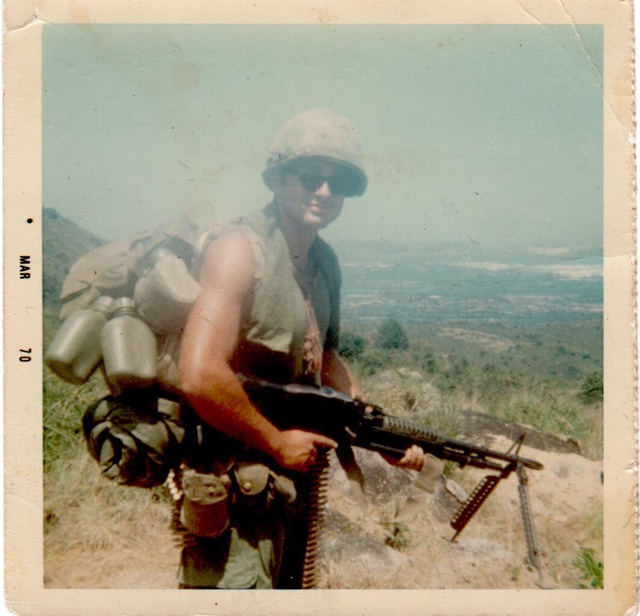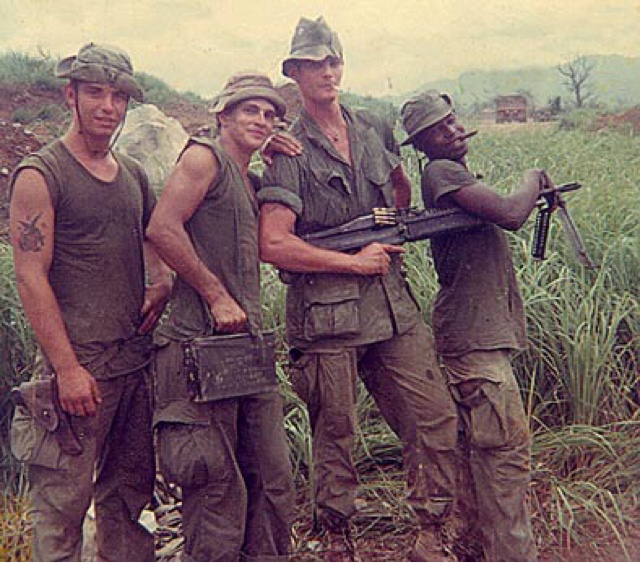In the early phases of U.S. involvement, both the first advisor era (1959-1964) and the early phase of the war proper (1965-mid 1966), there was that very marked "we'll be home by Christmas" mentality that seems to characterize the early part of every war the U.S. has ever been involved in. So, in that petty officiousness that every peacetime army has trouble letting go of when war comes, this translated to a strong push to maintain proper "uniform", even in the field, as well as clean, uncluttered vehicles that were free of personal effects and excess weapons:
By late 1966-1967, the idea that the war would be over soon, and the zeal that accompanied it, had faded somewhat, but there was still a fairly high degree of professional pride. Uniforms and vehicles looked a bit more "lived in" and began to show a more realistic grasp of tropical warfare. Non-political graffiti as a sign of comradery began to be tolerated by commanders and extra weapons begin to appear on vehicles more widely. There was less emphasis on keeping everything squeaky clean. This is also the point where white name tapes, polished metal rank insignia, and colorful unit shoulder patches disappeared off of uniforms, as they were providing convenient aiming points for the enemy. The large white stars started to be removed from vehicles for the same reason:
1968-1969 was a turning point. Tet proved that the war was nowhere near as "over" as all the Pentagon spin doctors had been claiming. The new President had already announced that U.S. troop levels would be reduced and more of the handling of the war would be given to the South Vietnamese. Graffiti that was decidedly political in nature began to appear. A creeping erosion of morale was rearing its head:
Beginning in 1970 and running through the troop withdrawal in 1973, as well as the second advisor period 1974-1975, a level of slovenliness set in that would have been utterly unthinkable five years earlier, which was indicative of the plummeting discipline and morale levels. Frontline US troops and their vehicles began to resemble rolling gypsy camps and a full uniform was virtually unheard of:
Being shirtless in 1965 (let alone openily nude), even in a rear area, would have landed you in the stockade. By 1970 and beyond, it was the norm (being shirtless, not nude).
So, what does all this mean for actual painting? Through 1965, a majority of uniforms would be darker, as most troops hadn't been in-country very long. Regardless of which phase of the war you're modeling, REPs (Rear Echelon Pukes) will almost always have a darker shade of uniform, as they aren't doing this on a daily basis:
As the war progressed, any given frontline unit's uniforms would be progressively more faded, with a few FNGs (F*cking New Guys) mixed in and only they having darker shades. Units in the field should show dirt/mud from the knees down, and often on the seat of the pants, elbows, and chest (from frequently being face down on the ground).
The wargamers' much beloved Mitchell helmet cover was renown for fading very very quickly in the tropical heat, sun, and rain, to the point that the pattern was often virtually invisible. Plain green helmet covers were also issued when Mitchell's were in short supply. Camouflage uniforms of any kind were unheard of among U.S. line troops and were the province of the Special Forces, SEALs, LRRPs, and South Vietnamese "elite" forces.
The later the period that you're modeling, the more graffiti you should apply and the more political and/or sexually suggestive (by 1960s standards) it should get, both for uniforms and vehicles. Personal items and excess weapons should progressively festoon vehicles as the later phases of the war arrive. Any attempt to be in proper "uniform" should disappear. Old hands will have very faded-out clothing and the percentage of FNGs in fresh uniforms in a unit will increase as the war progresses. Mustaches, long hair, and even a few beards will begin to appear in 1970-1973. All this applies equally to the Australians and U.S. Navy Brown Water boat crews. For the ARVN, uniforms and equipment will begin to show obvious deterioration and a faded look in 1971-1972, which will get progressively worse as the U.S. stopped providing supplies in 1973-1975.
A lot of gamers I know obsess over what green to use for U.S. uniforms. As you can see in all the above photos, any unit had a multitude of shades, depending on how long the wearer had been in Vietnam and in the field. Using a number of different shades of olive green will provide you with a realistic look. And don't forget to use a black or darker green wash to add prominent sweat stains down the center of the back and in large crescents under the arms. Having spent 18 mos in a tropical setting, I can tell you sweat is ever present and the areas of olive green uniforms that are wet appear a darker shade of green.
I hope this provides some insight and help in your painting of minis for the Vietnam War. And as an aside, I highly recommend "A Dictionary Of Soldier Talk" (John Elting, et al - January 1984) as an excellent collection of Vietnam-era military phrases used by the average soldier. It's available very cheaply from Amazon, Bookfinder.com, etc.






































Excellent stuff! I am painting for French Indo-China. Slightly different gear, same terrain, same heat and same mud. Very useful insights.
ReplyDeleteThanks.
My pleasure
DeleteLots of good stuff here, thanks for sharing it.
ReplyDeleteAlways my pleasure
DeleteMind a minor, minor nitpick?
ReplyDeleteThe M-551 Sheridan wasn't deployed to Vietnam until 1969, so it isn't really representative of the Advisory or pre-1966 era.
Nitpicks always welcome. True enough, but trying to find photos of "clean" vehicles in Vietnam is a challenge, as everyone wants those that are covered with graffiti. So, in the interests of illustration, I fudged slightly.
DeleteThat's entirely fair, sure! Sorry to be nitpicky; I'm a former armor crewman myself, and tend to focus on that sort of thing...
DeleteI'm always greatful for your observations. I was a REP for ten years!
Delete